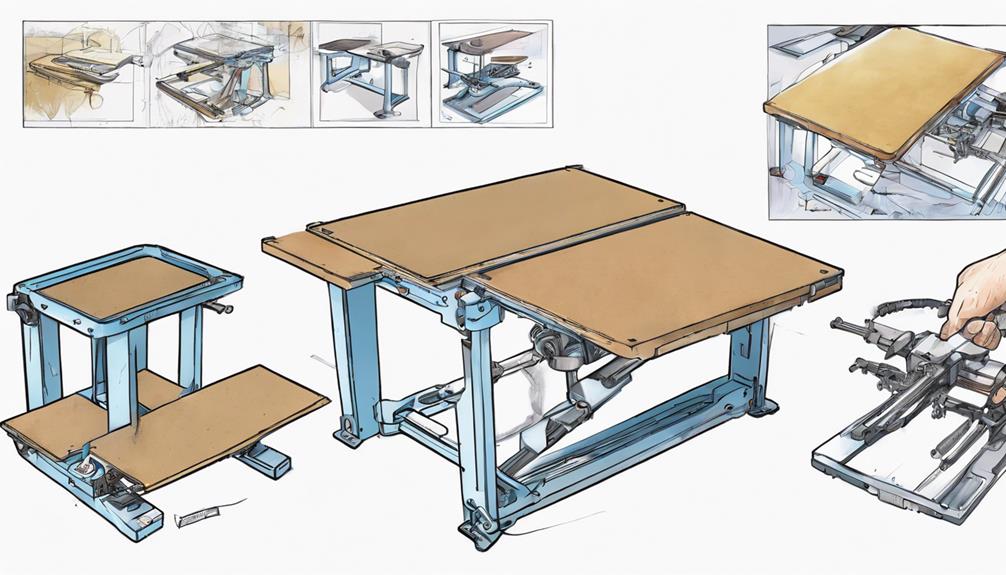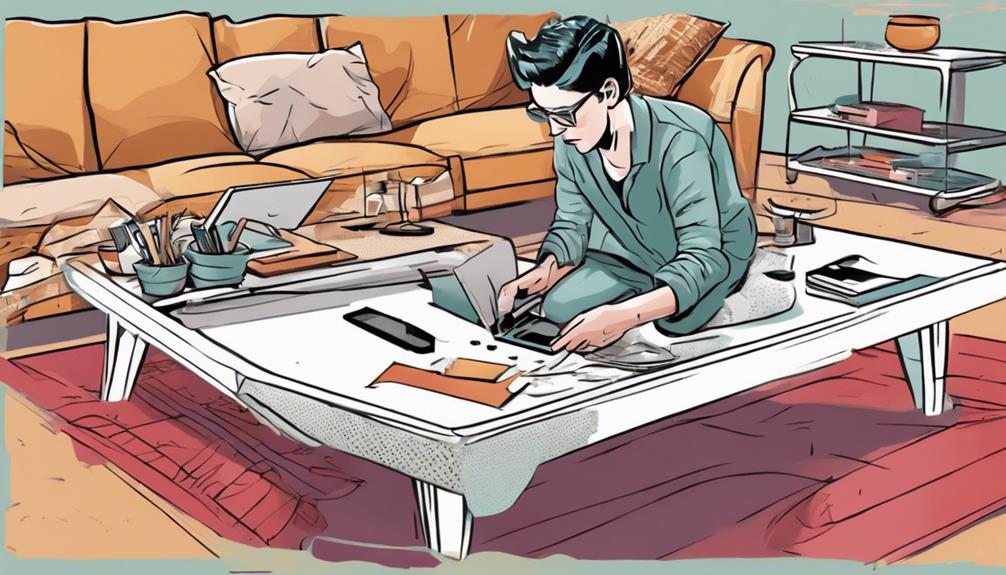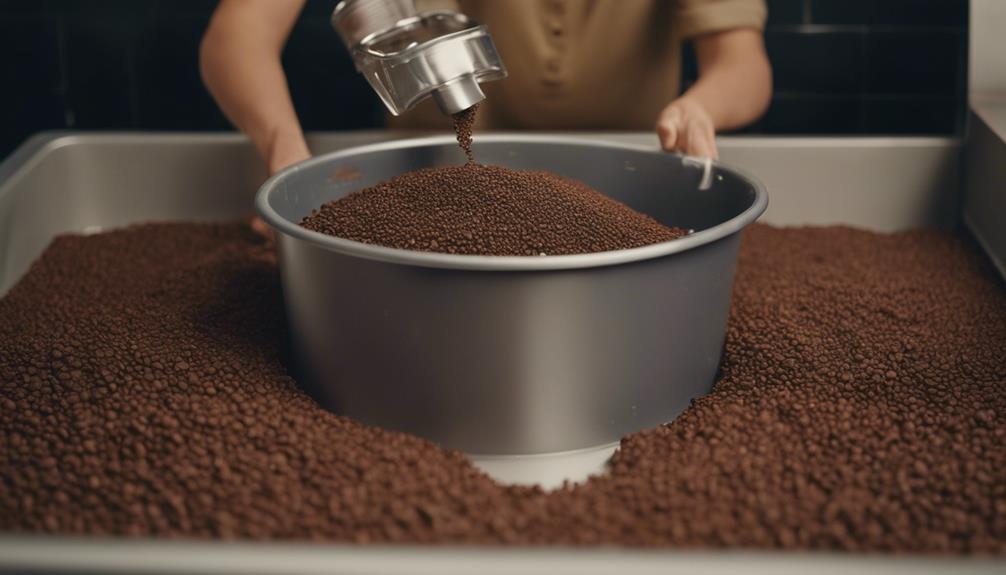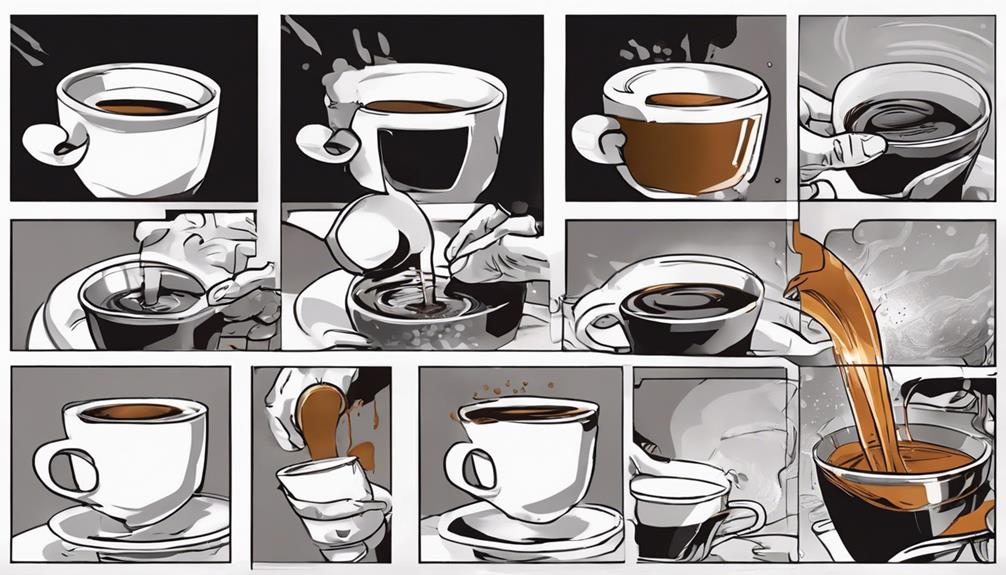To start putting together your coffee table, begin by securing the initial framework using metal and wood rods. Next, attach the drawer sides and knob to add both functionality and style. Make sure that the drawers slide smoothly by adjusting the slides properly and ensuring the drawer is in the correct position. Install the hydraulic lift to easily adjust the height of the table. Benefit from versatile storage options for crafting materials and organizing your workspace. The fold-out desk and hidden compartments bring both utility and elegance to your living area. To learn more about practical assembly steps and ways to improve your home setup, refer to the instructions provided. If you require more detailed step-by-step guidance, you can effortlessly assemble an Ikea Lack coffee table by following the manual provided. This will ensure that you have all the necessary parts and tools to complete the assembly efficiently. Additionally, the manual contains suggestions and techniques for customizing your coffee table to suit your individual style and preferences. Therefore, take your time and enjoy the process of creating a functional and stylish piece of furniture for your home.
Key Takeaways
- Follow step-by-step instructions for initial table structure assembly using metal and wood rods.
- Assemble the drawer by attaching sides, knob, and slides securely.
- Enhance style and functionality by adding a decorative knob to the drawer front.
- Install hydraulic lifts to adjust tabletop height for stable usage.
- Enjoy practical storage options like a pull-out desk and hidden compartments for efficient organization.
Initial Table Structure Assembly
To start putting together the coffee table, screw in the metal rods and use wood adhesive to attach the wood rods to create the initial framework. This step is essential in establishing a strong base for your table. By firmly securing the metal rods and wood rods together, you guarantee that the structure is stable and durable.
Once the initial framework is in place, the next step is to fasten the side walls and legs with metal locking rings. These rings offer additional stability and support, ensuring that your coffee table will endure daily use without wobbling or becoming unstable.
To strengthen the framework further, insert wood brackets using wood adhesive. These brackets provide extra support to key areas of the table, making it even more sturdy and long-lasting.
Drawer Assembly Process

You'll start by firmly screwing together the sides of the pull-out drawer for stability and durability.
Next, attach a decorative knob to the front of the drawer to make opening and closing easy.
Drawer Construction Steps
As you screw together the sides of the pull-out drawer, you form the structure for the drawer assembly process. This step is vital in creating a sturdy foundation for the drawer.
Next, you'll want to attach a decorative knob to the front of the drawer. This not only adds a touch of style but also provides an easy way to open and close the drawer.
After the knob is in place, secure the drawer slides to guarantee smooth sliding movement. This will make accessing items inside the drawer a breeze.
Once everything is assembled, slide the drawer into its designated spot within the coffee table. The process is simple and adds functionality to your coffee table, giving you a convenient storage option right at your fingertips.
Adding Decorative Knob
Attach the decorative knob to the front of the pull-out drawer to enhance both the style and functionality of the coffee table. This simple addition not only adds a touch of elegance but also makes it easier to open and close the drawer.
The knob's sleek design seamlessly integrates into the modern look of the table, elevating its overall aesthetic. By securing the decorative knob onto the drawer front, you complete the assembly process with a sophisticated finishing touch.
This functional and stylish feature serves as a convenient grip for effortless usage of the pull-out drawer. Its presence not only enhances the visual appeal of the coffee table but also adds a level of practicality to the furniture piece.
With the decorative knob in place, you'll appreciate the seamless blend of style and function it brings to your living space.
Final Drawer Placement
To complete the assembly process of the coffee table, the next step involves placing the assembled drawer securely into its designated slot on the table.
After screwing the drawer sides together and adding a decorative knob to the front, make sure the drawer slides are tightened down for smooth opening and closing.
Once the drawer is fully assembled, it effortlessly slides into place within the designated slot on the coffee table.
This straightforward drawer assembly process not only adds functionality but also provides a convenient storage option for your coffee table.
By finalizing the drawer placement, you're one step closer to enjoying your fully assembled and functional coffee table.
The secure placement of the drawer is essential in ensuring its stability and usability within the overall structure of the table.
Follow these simple steps to complete the assembly process efficiently and effectively.
Hydraulic Lift Installation

For effortless height adjustment, fasten the hydraulic lifts to the bottom of the tabletop inside the coffee table. Make certain to attach them securely to the interior of the coffee table to ensure stability. Lower the top piece and lock it into position to activate the hydraulic lift mechanism. This mechanism allows you to easily modify the tabletop height to your preference. Remember, the installation of the hydraulic lift is the final step in assembling your coffee table, so take your time to verify it is done correctly.
To assist you in visualizing the process better, refer to the table below:
| Hydraulic Lift Installation Steps | Description |
|---|---|
| 1. Attach lifts to tabletop bottom | Fasten lifts for height adjustment. |
| 2. Secure lifts inside the table | Guarantee stability. |
| 3. Lower top piece and lock | Activate lift mechanism. |
| 4. Adjust tabletop height | Effortless modification. |
| 5. Confirm stable installation | Final step in assembly. |
Practical Storage Options

You'll appreciate the versatile storage compartments that the coffee table offers, providing you with practical solutions to keep your space organized.
The convenient workspace solution allows you to work or enjoy your hobbies comfortably without cluttering your living area.
Additionally, the functional craft supply storage under the desk guarantees that your items are easily accessible whenever you need them.
Versatile Storage Compartments
How can the versatile storage compartments within the coffee table enhance the functionality of your living space? The practical storage options offered by the coffee table's compartments provide a convenient solution for keeping your living area organized and clutter-free. With ample storage space for craft supplies and other items, you can easily access your essentials while maintaining a neat appearance.
Here is a breakdown of the versatile storage compartments available in the coffee table:
| Storage Compartment | Functionality |
|---|---|
| Pull-out desk with storage compartment underneath | Offers a convenient workspace for tasks and activities. |
| Ample storage space | Perfect for storing craft supplies and miscellaneous items. |
| Versatile design | Allows for easy access to stored items while keeping your living space tidy. |
These storage options not only enhance the usability of the coffee table but also contribute to the overall efficiency and organization of your living area.
Convenient Workspace Solution
Effortlessly incorporating a practical workspace solution, the coffee table's pull-out desk provides a convenient area for various activities.
- The pull-out desk not only offers a sturdy surface for working on laptops or writing but also doubles as a concealed storage compartment underneath, perfect for organizing craft supplies or other essentials.
- Ample storage space within the coffee table guarantees that your living room stays clutter-free and organized, allowing for easy access to items you need.
- The combination of a fold-out desk and hidden storage makes this coffee table a versatile and functional piece of furniture suitable for any home setting.
- With its stylish design and utility, this coffee table seamlessly merges convenience and practicality, offering you a sleek workspace solution without compromising on storage options.
Functional Craft Supply Storage
The coffee table's pull-out desk offers a practical and efficient storage solution for organizing craft supplies and tools. The underside of the desk serves as a hidden compartment, providing a clever space to store your supplies out of sight yet easily accessible. With ample space within the coffee table, you have the flexibility to neatly organize various craft materials and tools. Its versatile storage options make the coffee table a functional piece for accommodating different crafting needs. The design of the table allows for effortless access and organization of your craft supplies, enhancing your crafting experience.
| Craft Supply Storage Features | Benefits | Usage |
|---|---|---|
| Pull-out desk with hidden compartment | Efficient use of space | Storing supplies out of sight |
| Ample space within the table | Organizing various craft materials | Easy access to tools |
| Versatile storage options | Practical for different crafting needs | Neatly organizing supplies |
Stylish and Functional Design

Featuring a blend of chic aesthetics and practical functionality, the coffee table's design seamlessly combines style with utility.
Here's what makes this coffee table a stylish and functional addition to your living space:
- The fold-out desk provides added utility and space-saving functionality, perfect for working or enjoying a meal.
- With a hydraulic lift mechanism, adjusting the tabletop height is a breeze, enhancing usability for various activities.
- Practical storage solutions abound, including a pull-out desk and an underside storage compartment, keeping your space tidy and organized.
- The coffee table's stylish design not only elevates the aesthetics of the room but also incorporates organizational features for a classy and functional piece that caters to your storage needs.
Affiliate Link for Purchase

By clicking the affiliate link provided, easily purchase the featured coffee table for prompt delivery. This streamlined process allows you to support the channel offering the assembly instructions while acquiring the stylish and practical coffee table mentioned in the guide. Simply click the link to be directed to the product page for a convenient ordering experience.
| Features | Benefits |
|---|---|
| Quick Delivery | Get your table fast |
| Easy Ordering | Trouble-free purchase |
| Supports the Channel | Assist the content creators |
| Convenient Process | Simplified purchasing |
| Direct Product Page | Immediate access to order |
Utilize the affiliate link to secure your coffee table effortlessly and efficiently. This direct pathway guarantees a seamless transaction and aids in maintaining the production of helpful assembly guides.
Frequently Asked Questions
How Do You Make a Coffee Table Arrangement?
To create a stunning coffee table arrangement, arrange decor in odd numbers with varying heights and textures. Consider your room's theme when choosing items. Leave some empty space for balance. Refresh the look by rotating seasonal pieces.
How Do You Layout a Coffee Table?
Imagine your space as a canvas – position the coffee table for easy access, leaving room to move. Decorate with purpose, balancing practicality and style. Coordinate items to create a focal point, enhancing the overall design.
How Do You Arrange Objects on a Coffee Table?
Arrange objects on a coffee table by using a tray for smaller items, stacking books or magazines for decoration and accessibility, adding plants or flowers for color, using decorative boxes to hide clutter, and mixing textures and heights for visual interest.
What Do You Put in the Middle of a Coffee Table?
In the middle of a coffee table, place a decorative tray with candles, books, and a plant for elegance. Add a vase with flowers for color. Consider a bowl with potpourri or trinkets. Use coasters, boxes, or sculptures for style. Mix textures for balance.
Conclusion
Now that you've completed assembling your coffee table, imagine the satisfaction of enjoying your morning cup of coffee on a stylish and functional piece of furniture you put together yourself.
With the practical storage options and hydraulic lift installation, your new table isn't only beautiful but also convenient for your everyday needs.
Cheers to a job well done!









